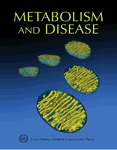|
LXXVI: Metabolism and Disease 2011 |
|
|

|
E. Gottlieb, A. Vazquez, S. Mason SYMPOSIUM SYNOPSIS LIST OF PARTICIPANTS CONTENTS OF SYMPOSIUM VOLUME PHOTOGRAPHS PUBLISHED VOLUME  |
Metabolism and Disease
June, 2011
Symposium Synopsis
Organizers: Terri Grodzicker, David Stewart & Bruce Stillman
Cold Spring Harbor Laboratory selected the theme of Metabolism and Disease for the historic 76th Symposium in the series. The decision to focus the 2011 Symposium on this topic reflects the growing convergence of lines of research in fields ranging from cancer biology to aging, demonstrating that key metabolic pathways regulate energy homeostasis in cells, organs, and whole organisms, and that many human diseases share profound dysfunction in metabolism at a molecular level. Previous Symposia that have been devoted in all or in part to metabolism and its dysfunction include Biological Oxidations (1939), The Mammalian Fetus: Physiological Aspects of Development (1954), Cellular Regulatory Mechanisms (1961), The Cardiovascular System (2002), and Clocks and Rhythms (2007).
A key theme of early 20th-century investigation, cellular bioenergetics, yielded a vast body of biochemical knowledge about key energy transformation processes such as oxidative phosphorylation and glycosylation. In contrast, the molecular biology revolution of the last half century has focused largely on how cells and organisms process information stored in nucleic acid and how these mechanisms are regulated during fundamental processes, such as cell division and development, or adapt and respond to external conditions. Tremendous light has been shed on processes such as DNA replication, transcription, RNA processing, and protein translation and, more recently, on signaling cascades, developmental lineages, and disease progression (e.g., oncogenesis). Much of this work has been done with little regard for the metabolic state of the cell, which could be safely ignored while the reductionist approach yielded such powerful results. But energy consumption at the cellular and organismal level is once again becoming a major theme of modern research, because imbalances in these processes are increasingly understood to be major contributory factors in many diseases that significantly impact society, including obesity, cardiovascular disease, diabetes, metabolic disorders, and cancer. Moreover, energy homeostasis appears to have a significant impact on the aging process itself.
The Symposium aimed to integrate a very broad field of investigative effort, bringing together advances in our understanding of energy intake, consumption, and storage (diet, exercise, and fat), oxygen regulation and hypoxia, circadian rhythms, and life span / aging. The Symposium explored metabolism at molecular (gene expression, posttranslational modifications, protein turnover, cofactors and integrators, hormones, and signals), organellar (mitochondria), cellular, organ system (cardiovascular, bone), and organismal (timing and life span) scales. Diseases impacted by metabolic imbalance or dysregulation that were covered in detail included diabetes, obesity, metabolic syndrome, and cancer. New and emerging technologies were presented for simultaneous monitoring of hundreds of metabolites that allow for sophisticated sampling of the metabolic state of cells. Because the Symposium covered such a broad field, by necessity much excellent work could not be included, and instead, the Proceedings should be viewed as a necessarily eclectic collection of some of the most interesting and stimulating work that came to the organizers attention during the 18 months before the meeting.
In arranging this Symposium, the organizers were dependent on the guidance of a broad cadre of advisors including Drs. Ron Evans, Lenny Guarente, David Sabatini, Bruce Spiegelman, Craig Thompson, Eileen White, and Douglas Wallace. Opening night speakers included Douglas Wallace, Ron Evans, Cynthia Kenyon, and Craig Thompson. Nobel laureates Joe Goldstein and Mike Brown jointly presented the Reginald Harris lecture on Surviving Starvation: Essential Role of the Ghrelin-Growth Hormone Axis. Cynthia Kenyon delivered a compelling Dorcas Cummings lecture on The Deadly Sweet Tooth to Laboratory friends, neighbors, and Symposium participants in advance of the annual dinner parties. Steven McKnight concluded the meeting with a masterful and thought-provoking summary.
This Symposium was attended by almost 300 scientists from more than 20 countries, and the program included 62 invited presentations and 131 poster presentations. To disseminate the latest results and discussion of the Symposium to a wider audience, attendees were able to share many of the Symposium talks with colleagues who were unable to attend by using the Leading Strand video archive, and interviews by Emilie Marcus, Miranda Robertson, Richard Sever, and Jan Witkowski with leading experts in the field were arranged during the Symposium and distributed as free video from the Cold Spring Harbor Symposium interviews website.
We thank Val Pakaluk, Mary Smith, and Ed Campodonico and his staff, in the Meetings and Courses Program, for their assistance in organizing and running the Symposium, and John Inglis and his staff at Cold Spring Harbor Laboratory Press, particularly Rena Steuer, Inez Sialiano, and Kathy Bubbeo, for publishing the printed and online versions of the Symposium proceedings. Photographer Connie Brukin captured candid snapshots throughout the meeting.
Funds to support this meeting were obtained from the National Institute of General Medical Sciences, the Eunice Kennedy Shriver National Institute of Child Health and Human Development, the National Institute of Diabetes and Digestive and Kidney Diseases, and the National Institute on Aging, all branches of the National Institutes of Health; Amgen; and Seahorse Biosciences. Financial support from the corporate sponsors of our meetings program is essential for these Symposia to remain a success and we are most grateful for their continued support.
Terri Grodzicker
David Stewart
Bruce Stillman
January 2012
Search images: